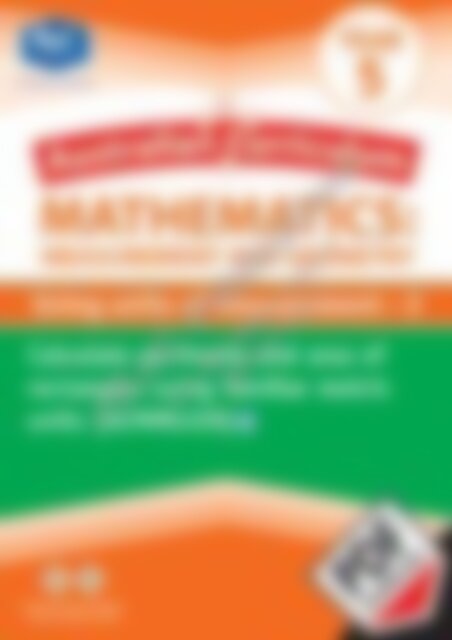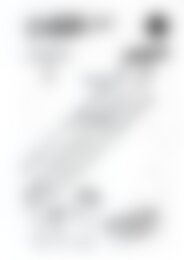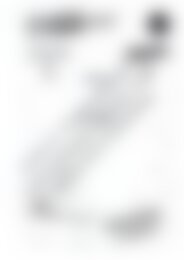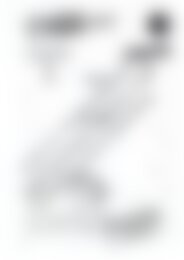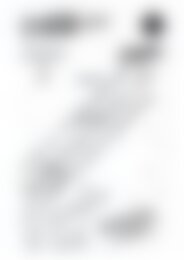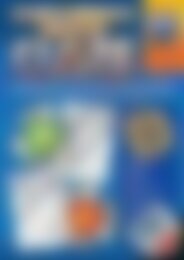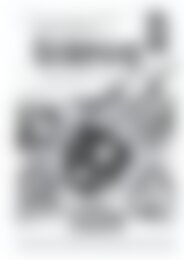RIC-20164 ACM Measurement and Geometry (Yr 5) Using units of measurement 2
Create successful ePaper yourself
Turn your PDF publications into a flip-book with our unique Google optimized e-Paper software.
©R.I.C. Publications<br />
Low Resolution Images<br />
Display Copy
Australian Curriculum Mathematics<br />
resource book: <strong>Measurement</strong> <strong>and</strong> <strong>Geometry</strong><br />
(Year 5)<br />
Published by R.I.C. Publications ® 2013<br />
Copyright © Linda Marshall 2013<br />
<strong>RIC</strong>–20172<br />
Titles in this series:<br />
Australian Curriculum Mathematics resource book:<br />
<strong>Measurement</strong> <strong>and</strong> <strong>Geometry</strong> (Foundation)<br />
Australian Curriculum Mathematics resource book:<br />
<strong>Measurement</strong> <strong>and</strong> <strong>Geometry</strong> (Year 1)<br />
Australian Curriculum Mathematics resource book:<br />
<strong>Measurement</strong> <strong>and</strong> <strong>Geometry</strong> (Year 2)<br />
Australian Curriculum Mathematics resource book:<br />
<strong>Measurement</strong> <strong>and</strong> <strong>Geometry</strong> (Year 3)<br />
Australian Curriculum Mathematics resource book:<br />
<strong>Measurement</strong> <strong>and</strong> <strong>Geometry</strong> (Year 4)<br />
Australian Curriculum Mathematics resource book:<br />
<strong>Measurement</strong> <strong>and</strong> <strong>Geometry</strong> (Year 5)<br />
Australian Curriculum Mathematics resource book:<br />
<strong>Measurement</strong> <strong>and</strong> <strong>Geometry</strong> (Year 6)<br />
All material identified by is material subject to<br />
copyright under the Copyright Act 1968 (Cth) <strong>and</strong> is owned<br />
by the Australian Curriculum, Assessment <strong>and</strong> Reporting<br />
Authority 2013.<br />
For all Australian Curriculum material except<br />
elaborations: This is an extract from the Australian<br />
Curriculum.<br />
Elaborations: This may be a modified extract from the<br />
Australian Curriculum <strong>and</strong> may include the work <strong>of</strong> other<br />
authors.<br />
Disclaimer: ACARA neither endorses nor verifies the<br />
accuracy <strong>of</strong> the information provided <strong>and</strong> accepts no<br />
responsibility for incomplete or inaccurate information. In<br />
particular, ACARA does not endorse or verify that:<br />
• The content descriptions are solely for a particular year<br />
<strong>and</strong> subject;<br />
• All the content descriptions for that year <strong>and</strong> subject<br />
have been used; <strong>and</strong><br />
• The author’s material aligns with the Australian<br />
Curriculum content descriptions for the relevant year<br />
<strong>and</strong> subject.<br />
You can find the unaltered <strong>and</strong> most up to date version <strong>of</strong><br />
this material at http://www.australiancurriculum.edu.au/<br />
This material is reproduced with the permission <strong>of</strong> ACARA.<br />
Copyright Notice<br />
A number <strong>of</strong> pages in this book are worksheets.<br />
The publisher licenses the individual teacher who<br />
purchased this book to photocopy these pages to h<strong>and</strong><br />
out to students in their own classes.<br />
Except as allowed under the Copyright Act 1968, any<br />
other use (including digital <strong>and</strong> online uses <strong>and</strong> the<br />
creation <strong>of</strong> overhead transparencies or posters) or any<br />
use by or for other people (including by or for other<br />
teachers, students or institutions) is prohibited. If you<br />
want a licence to do anything outside the scope <strong>of</strong> the<br />
BLM licence above, please contact the Publisher.<br />
This information is provided to clarify the limits <strong>of</strong> this<br />
licence <strong>and</strong> its interaction with the Copyright Act.<br />
For your added protection in the case <strong>of</strong> copyright<br />
inspection, please complete the form below. Retain this<br />
form, the complete original document <strong>and</strong> the invoice<br />
or receipt as pro<strong>of</strong> <strong>of</strong> purchase.<br />
Name <strong>of</strong> Purchaser:<br />
Date <strong>of</strong> Purchase:<br />
Supplier:<br />
School Order# (if applicable):<br />
Signature <strong>of</strong> Purchaser:<br />
©R.I.C. Publications<br />
Low Resolution Images<br />
Display Copy<br />
Internet websites<br />
In some cases, websites or specific URLs may be recommended. While these are checked <strong>and</strong> rechecked at the time <strong>of</strong> publication,<br />
the publisher has no control over any subsequent changes which may be made to webpages. It is strongly recommended that the class<br />
teacher checks all URLs before allowing students to access them.<br />
View all pages online<br />
PO Box 332 Greenwood Western Australia 6924<br />
Website: www.ricpublications.com.au<br />
Email: mail@ricgroup.com.au
Foreword<br />
AUSTRALIAN CUR<strong>RIC</strong>ULUM MATHEMATICS<br />
RESOURCE BOOK:<br />
MEASUREMENT AND GEOMETRY<br />
(YEAR 5)<br />
Australian Curriculum Mathematics resource book: <strong>Measurement</strong> <strong>and</strong> <strong>Geometry</strong> (Year 5) is one in a series <strong>of</strong> seven teacher resource books that support<br />
teaching <strong>and</strong> learning activities in Australian Curriculum Mathematics. The books focus on the <strong>measurement</strong> <strong>and</strong> geometry content str<strong>and</strong>s <strong>of</strong> the<br />
national maths curriculum. The resource books include theoretical background information, resource sheets, h<strong>and</strong>s-on activities <strong>and</strong> assessment<br />
activities, along with links to other curriculum areas.<br />
Format <strong>of</strong> this book ...................................................................... iv – v<br />
<strong>Using</strong> <strong>units</strong> <strong>of</strong> <strong>measurement</strong> ......................................................... 2–41<br />
• UUM – 1<br />
Choose appropriate <strong>units</strong> <strong>of</strong> <strong>measurement</strong> for length, area,<br />
volume, capacity <strong>and</strong> mass (<strong>ACM</strong>MG108)<br />
– Teacher information ............................................................................... 2–4<br />
– H<strong>and</strong>s-on activities ................................................................................. 5–8<br />
– Links to other curriculum areas .................................................................... 9<br />
– Resource sheets .................................................................................. 10–16<br />
– Assessment ........................................................................................ 17–18<br />
– Checklist .................................................................................................... 19<br />
• UUM – 2<br />
Calculate the perimeter <strong>and</strong> area <strong>of</strong> rectangles using familiar<br />
metric <strong>units</strong> (<strong>ACM</strong>MG109)<br />
– Teacher information .................................................................................. 20<br />
– H<strong>and</strong>s-on activities ............................................................................. 21–22<br />
– Links to other curriculum areas .................................................................. 23<br />
– Resource sheets .................................................................................. 24–25<br />
– Assessment ............................................................................................... 26<br />
– Checklist .................................................................................................... 27<br />
• UUM– 3<br />
Compare 12- <strong>and</strong> 24-hour time systems <strong>and</strong> convert<br />
between them (<strong>ACM</strong>MG110)<br />
– Teacher information ........................................................................... 28–29<br />
– H<strong>and</strong>s-on activities .................................................................................... 30<br />
– Links to other curriculum areas .................................................................. 31<br />
– Resource sheets .................................................................................. 32–38<br />
– Assessment ............................................................................................... 39<br />
– Checklist .................................................................................................... 40<br />
Answers .................................................................................. 41<br />
Shape ........................................................................................ 42–57<br />
• Shape – 1<br />
Connect three-dimensional objects with their nets <strong>and</strong> other<br />
two-dimensional representations (<strong>ACM</strong>MG111)<br />
– Teacher information .................................................................................. 42<br />
– H<strong>and</strong>s-on activities ............................................................................. 43–44<br />
– Links to other curriculum areas .................................................................. 45<br />
– Resource sheets .................................................................................. 46–53<br />
– Assessment ........................................................................................ 54–55<br />
– Checklist .................................................................................................... 56<br />
Answers .................................................................................. 57<br />
Contents<br />
Location <strong>and</strong> transformation .................................................... 58–115<br />
• L&T – 1<br />
Use a grid reference system to describe locations. Describe routes<br />
using l<strong>and</strong>marks <strong>and</strong> directional language (<strong>ACM</strong>MG113)<br />
– Teacher information ........................................................................... 58–59<br />
– H<strong>and</strong>s-on activities ............................................................................. 60–61<br />
– Links to other curriculum areas .................................................................. 62<br />
– Resource sheets .................................................................................. 63–69<br />
– Assessment ............................................................................................... 70<br />
– Checklist .................................................................................................... 71<br />
• L&T – 2<br />
Describe translations, refl ections <strong>and</strong> rotations <strong>of</strong> two-dimensional<br />
shapes. Identify line <strong>and</strong> rotational symmetries (<strong>ACM</strong>MG114)<br />
– Teacher information ........................................................................... 72–74<br />
– H<strong>and</strong>s-on activities ............................................................................. 75–78<br />
– Links to other curriculum areas .................................................................. 79<br />
– Resource sheets .................................................................................. 80–92<br />
– Assessment ........................................................................................ 93–94<br />
– Checklist .................................................................................................... 95<br />
• L&T – 3<br />
Apply the enlargement transformation to familiar two-dimensional<br />
shapes <strong>and</strong> explore the properties <strong>of</strong> the resulting image compared with<br />
the original (<strong>ACM</strong>MG115)<br />
©R.I.C. Publications<br />
Low Resolution Images<br />
Display Copy<br />
– Teacher information .................................................................................. 96<br />
– H<strong>and</strong>s-on activities ............................................................................. 97–98<br />
– Links to other curriculum areas .................................................................. 99<br />
– Resource sheets .............................................................................. 100–110<br />
– Assessment .................................................................................... 111–112<br />
– Checklist .................................................................................................. 113<br />
Answers ........................................................................ 114–115<br />
Geometric reasoning .............................................................. 116–133<br />
• GR – 1<br />
Estimate, measure <strong>and</strong> compare angles using degrees. Construct angles<br />
using a protractor (<strong>ACM</strong>MG112)<br />
– Teacher information ....................................................................... 116–117<br />
– H<strong>and</strong>s-on activities ......................................................................... 118–119<br />
– Links to other curriculum areas ................................................................ 120<br />
– Resource sheets .............................................................................. 121–129<br />
– Assessment .................................................................................... 130–131<br />
– Checklist .................................................................................................. 132<br />
Answers ................................................................................ 133<br />
Australian Curriculum Mathematics resource book: <strong>Measurement</strong> <strong>and</strong> <strong>Geometry</strong> (Year 5) R.I.C. Publications ® www.ricpublications.com.au iii
FORMAT OF THIS BOOK<br />
This teacher resource book includes supporting materials for teaching <strong>and</strong> learning in all sections <strong>of</strong> the <strong>Measurement</strong> <strong>and</strong> <strong>Geometry</strong> content str<strong>and</strong> <strong>of</strong><br />
Australian Curriculum Mathematics. It includes activities relating to all sub-str<strong>and</strong>s: <strong>Using</strong> <strong>units</strong> <strong>of</strong> <strong>measurement</strong>, Shape, Location <strong>and</strong> transformation<br />
<strong>and</strong> Geometric reasoning. All content descriptions have been included, as well as teaching points based on the Curriculum’s elaborations. Links to the<br />
pr<strong>of</strong>iciency str<strong>and</strong>s have also been included.<br />
Each section supports a specific content description <strong>and</strong> follows a consistent format, containing the following information over several pages:<br />
• teacher information with related terms, student vocabulary, what the content description means, teaching points <strong>and</strong> problems to watch for<br />
• h<strong>and</strong>s-on activities<br />
• resource sheets<br />
• a checklist<br />
• links to other curriculum areas<br />
• assessment sheets.<br />
Answers relating to the resource <strong>and</strong> assessment pages are included on the final page <strong>of</strong> the section for each sub-str<strong>and</strong> (<strong>Using</strong> <strong>units</strong> <strong>of</strong> <strong>measurement</strong>,<br />
Shape, Location <strong>and</strong> transformation <strong>and</strong> Geometric reasoning).<br />
The length <strong>of</strong> each content description section varies.<br />
Related terms includes vocabulary associated<br />
with the content description. Many <strong>of</strong> these<br />
relate to the glossary in the back <strong>of</strong> the <strong>of</strong>ficial<br />
Australian Curriculum Mathematics document;<br />
additional related terms may also have been<br />
added.<br />
Student vocabulary includes words which<br />
the teacher would use—<strong>and</strong> expect the<br />
students to learn, underst<strong>and</strong> <strong>and</strong> use—during<br />
mathematics lessons.<br />
The pr<strong>of</strong>iciency str<strong>and</strong>(s) (Underst<strong>and</strong>ing,<br />
Fluency, Problem Solving solving or Reasoning) relevant<br />
to each content description are listed. shown in bold.<br />
Teacher information includes background information relating to the content description, as well as<br />
related terms, desirable student vocabulary <strong>and</strong> other useful details which may assist the teacher.<br />
What this means provides<br />
a general explanation <strong>of</strong> the<br />
content description.<br />
Teaching points provides<br />
a list <strong>of</strong> the main teaching<br />
points relating to the content<br />
description.<br />
What to watch look for for suggests any any<br />
difficulties <strong>and</strong> misconceptions<br />
the students might encounter or<br />
develop.<br />
©R.I.C. Publications<br />
Low Resolution Images<br />
Display Copy<br />
H<strong>and</strong>s-on activities includes descriptions or<br />
instructions for games or activities relating to the<br />
content descriptions or elaborations. Some <strong>of</strong> the<br />
h<strong>and</strong>s-on activities are supported by resource<br />
sheets. Where applicable, these will be stated for<br />
easy reference.<br />
iv Australian Curriculum Mathematics resource book: <strong>Measurement</strong> <strong>and</strong> <strong>Geometry</strong> (Year 5) R.I.C. Publications ® www.ricpublications.com.au
FORMAT OF THIS BOOK<br />
Links to other curriculum areas includes activities in other curriculum areas which support<br />
the content description. These are English, Information <strong>and</strong> Communication Technology (ICT),<br />
Health <strong>and</strong> Physical Education, History, Geography, the Arts <strong>and</strong> Languages. This section may list<br />
many links or only a few. It may also provide links to relevant interactive websites appropriate<br />
for the age group.<br />
Cross-curricular links reinforce the knowledge that mathematics can be found within, <strong>and</strong><br />
relates to, many other aspects <strong>of</strong> student learning <strong>and</strong> everyday life.<br />
Resource sheets are provided to support<br />
teaching <strong>and</strong> learning activities for each<br />
content description. The resource sheets<br />
could be cards for games, charts, additional<br />
worksheets for class use or other materials<br />
which the teacher might find useful to use or<br />
display in the classroom. For each resource<br />
sheet, the content description to which it<br />
relates is given.<br />
Assessment pages are included. These<br />
support activities in the H<strong>and</strong>s-on activities<br />
or resource sheets.<br />
©R.I.C. Publications<br />
Low Resolution Images<br />
Display Copy<br />
Each section has a checklist which teachers<br />
may find useful as a place to keep a record <strong>of</strong><br />
the results <strong>of</strong> assessment activities, or their<br />
observations <strong>of</strong> h<strong>and</strong>s-on activities.<br />
Answers for resource pages (where<br />
appropriate) <strong>and</strong> assessment pages are<br />
provided on the final page <strong>of</strong> each sub-str<strong>and</strong><br />
section.<br />
Australian Curriculum Mathematics resource book: <strong>Measurement</strong> <strong>and</strong> <strong>Geometry</strong> (Year 5) R.I.C. Publications ® www.ricpublications.com.au v
Sub-str<strong>and</strong>: <strong>Using</strong> <strong>units</strong> <strong>of</strong> <strong>measurement</strong>—UUM – 2<br />
Calculate the perimeter <strong>and</strong> area <strong>of</strong> rectangles using familiar metric <strong>units</strong> (<strong>ACM</strong>MG109)<br />
RELATED TERMS<br />
TEACHER INFORMATION<br />
Perimeter<br />
• A measure <strong>of</strong> the distance around the<br />
boundary <strong>of</strong> a two-dimensional shape.<br />
Area<br />
• The amount <strong>of</strong> surface covered (i.e.<br />
2-D; measured in square <strong>units</strong>).<br />
Familiar metric <strong>units</strong><br />
• For perimeter, use centimetres, metres<br />
<strong>and</strong> kilometres. For area, use square<br />
centimetres, square metres <strong>and</strong> square<br />
kilometres. Large areas <strong>of</strong> l<strong>and</strong> may<br />
also be measured in hectares, though<br />
students would not be expected to<br />
work with this unit at this year level.<br />
Student vocabulary<br />
What does it mean<br />
• There is no direct relationship between the area <strong>and</strong> perimeter <strong>of</strong><br />
rectangles. Two rectangles with the same area may have different<br />
perimeters <strong>and</strong> two rectangles with the same perimeter may have<br />
different areas.<br />
• It is not necessarily the case that, as the perimeter <strong>of</strong> a rectangle<br />
is increased or decreased, the area <strong>of</strong> the rectangle is increased or<br />
decreased.<br />
• Students should be led to ‘discover’ the formula for calculating the<br />
perimeter or area <strong>of</strong> a rectangle.<br />
Teaching points<br />
• Students may measure the lengths <strong>of</strong> the four sides <strong>of</strong> a rectangle<br />
<strong>and</strong> add them together to obtain the perimeter. They may then<br />
‘discover’ that a more efficient way to calculate the perimeter is<br />
to double the lengths <strong>of</strong> the two different sides <strong>and</strong> add them<br />
together.<br />
• Students will have had experience in finding the areas <strong>of</strong><br />
rectangles by counting squares. The next step is to find the<br />
number <strong>of</strong> squares in each row <strong>and</strong> then work out how many rows<br />
there are. Students should explore the relationships rather than<br />
the teacher simply telling them a formula.<br />
• Teachers need to stress that the formulas for working out the<br />
perimeters <strong>and</strong> areas <strong>of</strong> rectangles only pertain to rectangles <strong>and</strong><br />
are not necessarily appropriate for other shapes.<br />
• Use the language ‘square centimetres’ not ‘centimetres squared’;<br />
they mean different things. For example, 2 cm 2 (2 square<br />
centimetres) means 2 lots <strong>of</strong> 1 cm x 1 cm squares. Two centimetres<br />
squared means a square with a length <strong>of</strong> 2 cm <strong>and</strong> a width <strong>of</strong> 2 cm<br />
(which is actually 4 square centimetres).<br />
©R.I.C. Publications<br />
Low Resolution Images<br />
Display Copy<br />
What to look for<br />
• Students confused about the difference between perimeter <strong>and</strong><br />
area.<br />
• Students believing that there is a direct relationship between the<br />
perimeter <strong>and</strong> area <strong>of</strong> a rectangles.<br />
perimeter<br />
area<br />
centimetres<br />
metres<br />
kilometres<br />
square centimetres<br />
square metres<br />
square kilometres<br />
Pr<strong>of</strong>iciency str<strong>and</strong>(s):<br />
Underst<strong>and</strong>ing<br />
Fluency<br />
Problem solving<br />
Reasoning<br />
20 Australian Curriculum Mathematics resource book: <strong>Measurement</strong> <strong>and</strong> <strong>Geometry</strong> (Year 5) R.I.C. Publications ® www.ricpublications.com.au
Sub-str<strong>and</strong>: <strong>Using</strong> <strong>units</strong> <strong>of</strong> <strong>measurement</strong>—UUM – 2<br />
HANDS-ON ACTIVITIES<br />
• Students construct rectangles on 1 cm 2 grid paper (see page 11). They record the size <strong>of</strong> the length <strong>and</strong> widths <strong>and</strong> add<br />
them together to determine the perimeter. Students can be ‘led’ to realise that if they double the size <strong>of</strong> the length <strong>and</strong><br />
the size <strong>of</strong> the width, then add those two figures together, they have found an efficient way to calculate the perimeter<br />
<strong>of</strong> a rectangle. Another method for calculating the perimeter <strong>of</strong> a rectangle is to add the size <strong>of</strong> the length <strong>and</strong> width<br />
together <strong>and</strong> double the result.<br />
3 cm<br />
5 cm<br />
The length <strong>of</strong> the rectangle<br />
is 5 cm, the width is 3 cm.<br />
• Students investigate how to calculate the perimeter <strong>of</strong> a square, which is a ‘special’ type <strong>of</strong> rectangle. They could use the<br />
above method, but may realise that as all four sides <strong>of</strong> a square are equal, they only need to work out the length <strong>of</strong> one<br />
side <strong>and</strong> multiply it by four.<br />
• Find the perimeter <strong>of</strong> Geoboard shapes. These do not need to be just one rectangle or square, but can be combinations,<br />
as below.<br />
The perimeter is<br />
8 <strong>units</strong><br />
The perimeter is<br />
12 <strong>units</strong><br />
• Use eight squares <strong>and</strong> investigate how many different shapes can be made. Some examples are shown below. Discuss<br />
which shape has the longest perimeter. Why are some <strong>of</strong> the perimeters different if all the shapes are made with eight<br />
squares? What types <strong>of</strong> shapes have the longer/shorter perimeters?<br />
3 cm<br />
The perimeter is 5 + 5 + 3<br />
+ 3, which is 16 cm. This is<br />
the same as 10 cm (2 x 5)<br />
+ 6 cm (2 x 3).<br />
The perimeter is<br />
18 <strong>units</strong><br />
©R.I.C. Publications<br />
Low Resolution Images<br />
Display Copy<br />
Australian Curriculum Mathematics resource book: <strong>Measurement</strong> <strong>and</strong> <strong>Geometry</strong> (Year 5) R.I.C. Publications ® www.ricpublications.com.au 21
HANDS-ON ACTIVITIES (CONTINUED)<br />
Sub-str<strong>and</strong>: <strong>Using</strong> <strong>units</strong> <strong>of</strong> <strong>measurement</strong>—UUM – 2<br />
• Students work out the area <strong>of</strong> a rectangle by counting the total number <strong>of</strong> squares, one at a time. Next, they count<br />
the number <strong>of</strong> squares in one row <strong>and</strong> work out how many rows there are altogether. Students then investigate any<br />
relationship between the sets <strong>of</strong> figures. To assist in this, a table could be drawn up.<br />
Rectangle<br />
Rectangle<br />
Number <strong>of</strong> squares in<br />
each row (length)<br />
Number <strong>of</strong> rows<br />
(width)<br />
Total area<br />
1 5 3 15 cm 2<br />
2<br />
3<br />
Number <strong>of</strong> squares in<br />
each row (length)<br />
Number <strong>of</strong> rows<br />
(width)<br />
Perimeter<br />
Total area<br />
1 5 3 10 + 6 = 16 cm 15 cm 2<br />
2<br />
3<br />
Area <strong>of</strong> each row <strong>of</strong> the<br />
rectangle is 5 cm 2<br />
There are 3 rows; so the area<br />
<strong>of</strong> the rectangle is 15 cm 2<br />
• Students may use a similar format to the one above, but include a column for calculating <strong>and</strong> recording the perimeters.<br />
• <strong>Using</strong> a Geoboard, students investigate area <strong>and</strong> perimeter <strong>of</strong> various shapes.<br />
©R.I.C. Publications<br />
Low Resolution Images<br />
Display Copy<br />
The perimeter is 8<br />
<strong>units</strong> <strong>and</strong> the area is<br />
3 square <strong>units</strong>.<br />
The perimeter is 12<br />
<strong>units</strong> <strong>and</strong> the area is 6<br />
square <strong>units</strong>.<br />
The perimeter is 18 <strong>units</strong> <strong>and</strong><br />
the area is 9 square <strong>units</strong>.<br />
22 Australian Curriculum Mathematics resource book: <strong>Measurement</strong> <strong>and</strong> <strong>Geometry</strong> (Year 5) R.I.C. Publications ® www.ricpublications.com.au
Sub-str<strong>and</strong>: <strong>Using</strong> <strong>units</strong> <strong>of</strong> <strong>measurement</strong>—UUM – 2<br />
LINKS TO OTHER CUR<strong>RIC</strong>ULUM AREAS<br />
Information <strong>and</strong> Communication Technology<br />
• Students can calculate the perimeters <strong>of</strong> shapes on the website <br />
• A shape surveyor that looks at area <strong>and</strong> perimeter <strong>of</strong> rectangles can be found at <br />
• The Shape Explorer can be found at You can choose<br />
to have only rectangular shapes for this activity. It also has the option <strong>of</strong> looking at the areas <strong>and</strong> perimeters <strong>of</strong> the<br />
shapes students have worked with in table format.<br />
• A catchy YouTube song on perimeter <strong>and</strong> area can be found at <br />
It goes straight to multiplication for working out the area <strong>of</strong> a rectangle, so this could be used after students have<br />
‘discovered’ how the formula works.<br />
• A perimeter rap song can be found on YouTube at It shows some <strong>of</strong> the <strong>measurement</strong>s in inches <strong>and</strong> others in centimetres.<br />
• An activity where students use perimeter <strong>and</strong> area to launch a ship can be found at The instructions are a little unclear, but students will soon get the hang <strong>of</strong> it.<br />
• A Design a Party planning activity where students look for particular rectangles with given areas <strong>and</strong> perimeters can be<br />
found at <br />
©R.I.C. Publications<br />
Low Resolution Images<br />
Display Copy<br />
Australian Curriculum Mathematics resource book: <strong>Measurement</strong> <strong>and</strong> <strong>Geometry</strong> (Year 5) R.I.C. Publications ® www.ricpublications.com.au 23
Sub-str<strong>and</strong>: <strong>Using</strong> <strong>units</strong> <strong>of</strong> <strong>measurement</strong>—UUM – 2<br />
Materials:<br />
8 square tiles<br />
1 cm 2 grid paper<br />
(a)<br />
(b)<br />
(c)<br />
(d)<br />
(e)<br />
Examples:<br />
RESOURCE SHEET<br />
Area the same<br />
• This square is 1 unit long <strong>and</strong> 1 unit wide.<br />
Its perimeter is 4 <strong>units</strong>.<br />
• Tina the tiler has 8 tiles. She must use all the tiles<br />
so she always has an area <strong>of</strong> 8 square <strong>units</strong>.<br />
• She has arranged her tiles like this<br />
to get a perimeter <strong>of</strong> 12 <strong>units</strong>.<br />
2 <strong>units</strong><br />
1. Do the same with your tiles. Make a copy <strong>of</strong> Tina’s floor on your grid paper.<br />
Shape Area Perimeter<br />
8 square <strong>units</strong> 12 <strong>units</strong><br />
8 square <strong>units</strong><br />
8 square <strong>units</strong><br />
8 square <strong>units</strong><br />
8 square <strong>units</strong><br />
8 square <strong>units</strong><br />
1 unit<br />
4 <strong>units</strong><br />
4 <strong>units</strong><br />
2. Help Tina by making these 5 different floors, using all 8 tiles for each one <strong>and</strong> copy<br />
each floor on grid paper.<br />
(a)<br />
(b)<br />
(c)<br />
a perimeter <strong>of</strong> 12 <strong>units</strong> (different from the one above)<br />
a perimeter <strong>of</strong> 14 <strong>units</strong><br />
a perimeter <strong>of</strong> 16 <strong>units</strong><br />
(d) <strong>and</strong> (e) two different floors with a perimeter <strong>of</strong> 18 <strong>units</strong>.<br />
1 unit<br />
1 unit<br />
1 unit<br />
2 <strong>units</strong><br />
Write the area <strong>and</strong> perimeter next to each shape <strong>and</strong> complete the table to show your<br />
results.<br />
3. Write about your results.<br />
©R.I.C. Publications<br />
Low Resolution Images<br />
Display Copy<br />
CONTENT DESCRIPTION: Calculate the perimeter <strong>and</strong> area <strong>of</strong> rectangles using familiar metric <strong>units</strong><br />
24 Australian Curriculum Mathematics resource book: <strong>Measurement</strong> <strong>and</strong> <strong>Geometry</strong> (Year 5) R.I.C. Publications ® www.ricpublications.com.au
Sub-str<strong>and</strong>: <strong>Using</strong> <strong>units</strong> <strong>of</strong> <strong>measurement</strong>—UUM – 2<br />
RESOURCE SHEET<br />
Perimeter the same<br />
Materials:<br />
Examples:<br />
CONTENT DESCRIPTION: Calculate the perimeter <strong>and</strong> area <strong>of</strong> rectangles using familiar metric <strong>units</strong><br />
8 square tiles<br />
1 cm 2 grid paper<br />
• This square is 1 unit long <strong>and</strong> 1 unit wide.<br />
Its perimeter is 4 <strong>units</strong>.<br />
• Arrange 8 tiles like this.<br />
• The area is 8 square <strong>units</strong><br />
The perimeter is 12 <strong>units</strong>.<br />
1. Do the same with your tiles. Make a copy <strong>of</strong> this floor on your grid paper.<br />
2. Make the perimeter stay at 12 <strong>units</strong> by removing different numbers <strong>of</strong> tiles, then<br />
copy each floor on grid paper:<br />
(a)<br />
(b)<br />
(c)<br />
(a)<br />
(b)<br />
(c)<br />
1 tile<br />
2 tiles<br />
3 tiles<br />
Write the area <strong>and</strong> perimeter next to each shape <strong>and</strong> complete the table to show your<br />
results.<br />
Shape Area Perimeter<br />
3. Write about your results.<br />
2 <strong>units</strong><br />
1 unit<br />
4 <strong>units</strong><br />
4 <strong>units</strong><br />
1 unit<br />
1 unit<br />
2 <strong>units</strong><br />
8 square <strong>units</strong> 12 <strong>units</strong><br />
12 <strong>units</strong><br />
12 <strong>units</strong><br />
12 <strong>units</strong><br />
1 unit<br />
©R.I.C. Publications<br />
Low Resolution Images<br />
Display Copy<br />
Australian Curriculum Mathematics resource book: <strong>Measurement</strong> <strong>and</strong> <strong>Geometry</strong> (Year 5) R.I.C. Publications ® www.ricpublications.com.au 25
Assessment 1 Sub-str<strong>and</strong>: <strong>Using</strong> <strong>units</strong> <strong>of</strong> <strong>measurement</strong>—UUM – 2<br />
NAME:<br />
DATE:<br />
Twelve squares<br />
1. (a) Find the area <strong>and</strong> perimeter <strong>of</strong> each shape below.<br />
(b)<br />
(c)<br />
Which shapes have the same perimeter?<br />
Which shapes have the same area?<br />
(i) (ii) (iii)<br />
(iv)<br />
P =<br />
cm<br />
A = cm 2 P = cm<br />
A = cm 2 P = cm<br />
P =<br />
cm<br />
(v)<br />
A = cm 2 P = cm<br />
2. (a) What is the perimeter <strong>of</strong> this rectangle?<br />
(b)<br />
What is its area?<br />
3. Materials: 12 square tiles<br />
(a)<br />
(b)<br />
(c)<br />
A = cm 2<br />
Make the three different rectangles that are possible with 12 tiles.<br />
Draw the rectangles in the first column <strong>of</strong> the table.<br />
Complete the table.<br />
Sketch <strong>of</strong> rectangle Length Width Perimeter Area<br />
4. Write about what you found.<br />
12 <strong>units</strong> 1 unit 26 <strong>units</strong><br />
A = cm 2<br />
©R.I.C. Publications<br />
Low Resolution Images<br />
Display Copy<br />
12 square<br />
<strong>units</strong><br />
CONTENT DESCRIPTION: Calculate the perimeter <strong>and</strong> area <strong>of</strong> rectangles using familiar metric <strong>units</strong><br />
26 Australian Curriculum Mathematics resource book: <strong>Measurement</strong> <strong>and</strong> <strong>Geometry</strong> (Year 5) R.I.C. Publications ® www.ricpublications.com.au
Sub-str<strong>and</strong>: <strong>Using</strong> <strong>units</strong> <strong>of</strong> <strong>measurement</strong>—UUM – 2<br />
Checklist<br />
Calculate the perimeter <strong>and</strong> area <strong>of</strong> rectangles using familiar metric <strong>units</strong> (<strong>ACM</strong>MG109)<br />
STUDENT NAME<br />
Underst<strong>and</strong>s how to<br />
calculate the perimeter<br />
<strong>of</strong> rectangles<br />
Underst<strong>and</strong>s how to<br />
calculate the area <strong>of</strong><br />
rectangles<br />
Compares area <strong>and</strong><br />
perimeter <strong>of</strong> rectangles<br />
©R.I.C. Publications<br />
Low Resolution Images<br />
Display Copy<br />
Australian Curriculum Mathematics resource book: <strong>Measurement</strong> <strong>and</strong> <strong>Geometry</strong> (Year 5) R.I.C. Publications ® www.ricpublications.com.au 27
Sub-str<strong>and</strong>: <strong>Using</strong> <strong>units</strong> <strong>of</strong> <strong>measurement</strong><br />
Answers<br />
Area<br />
UUM –1<br />
3. The perimeters are all the same (12 <strong>units</strong>), but the<br />
areas are different.<br />
Page 10 Resource sheet – Paperclip chains<br />
Page 26 Assessment 1 – Twelve squares<br />
Teacher check<br />
1. (a) (i) P = 12 cm A = 6 cm 2 (ii) P = 16 cm A = 9 cm 2<br />
Page 12 Resource sheet – Ambitious areas<br />
(iii) P = 18 cm A = 8 cm 2 (iv) P = 12 cm A = 5 cm 2<br />
1.–2. Teacher check<br />
(v) P = 12 cm A = 8 cm 2<br />
3. Bird: 19.5 squares Rabbit: 26 squares<br />
(b) (i) (iv) (v) (c) (iii) (v)<br />
2. (a) 22 <strong>units</strong> (b) 10 square <strong>units</strong><br />
Page 13 Resource sheet – Boxes <strong>of</strong> eight<br />
3. (a) Teacher check<br />
Teacher check<br />
(b)–(c)<br />
Page 14–15 Resource sheet – Mystery tour<br />
Sketch Length Width Perimeter<br />
3 5 cm 4 cm 2 cm 40 cm 3 80 cm 2 (g) 7:14 am<br />
(h) 4:21 pm<br />
You will be taken to the zoo.<br />
12 square<br />
12 <strong>units</strong> 1 unit 26 <strong>units</strong><br />
<strong>units</strong><br />
Page 16 Resource sheet – Units <strong>of</strong> length<br />
12 square<br />
6 <strong>units</strong> 2 <strong>units</strong> 16 <strong>units</strong><br />
<strong>units</strong><br />
1. (a) tape measure (b) 30 cm ruler<br />
(c) tape measure (d) tape measure or 1 m ruler<br />
12 square<br />
4 <strong>units</strong> 3 <strong>units</strong> 14 <strong>units</strong><br />
<strong>units</strong><br />
(e) trundle wheel (f) 30 cm ruler<br />
(g) trundle wheel (h) pedometer<br />
4. The areas are the same for all <strong>of</strong> the rectangles, but<br />
the perimeters are different. The longer <strong>and</strong> thinner<br />
2. Teacher check<br />
the shape, the greater the perimeter.<br />
Page 17 Assessment 1 – Units <strong>of</strong> length<br />
UUM – 3<br />
Teacher check<br />
Page 33 Resource sheet – The 24-hour clock<br />
Page 18 Assessment 2 – Boxes <strong>and</strong> more boxes<br />
1. (a) 0400 (b) 1400<br />
1. (a) Teacher check (b) 24 cm 3<br />
(c) 1200 (d) 2400<br />
(c) Their volume is the same, but their shapes are<br />
(e) 1223 (f) 0525<br />
different.<br />
(g) 2115 (h) 0420<br />
2. (b)<br />
Surface<br />
Prism Length Width Height Volume<br />
area 2. (a) 1:48 pm (b) 3:44 am<br />
1 3 cm 3 cm 3 cm 27 cm 3 54 cm 2<br />
(c) 10:15 pm (d) 6:05 pm<br />
2 2 cm 2 cm 1 cm 4 cm 3 16 cm 2<br />
(e) 11:11 am (f) 10:22 pm<br />
UUM – 2<br />
(c) Teacher check<br />
Page 24 Resource sheet – Area the same<br />
1. Teacher check<br />
2. a perimeter <strong>of</strong> 12 <strong>units</strong> P = 12; A = 8<br />
a perimeter <strong>of</strong> 14 <strong>units</strong> P = 14; A = 8<br />
a perimeter <strong>of</strong> 16 <strong>units</strong> P = 16; A = 8<br />
a perimeter <strong>of</strong> 18 <strong>units</strong> P = 18; A = 8<br />
a perimeter <strong>of</strong> 18 <strong>units</strong> P = 18; A = 8<br />
3. The areas are all the same (8 square <strong>units</strong>), but the<br />
perimeters are different.<br />
Page 25 Resource sheet – Perimeter the same<br />
1. Teacher check<br />
2. (a) 1 tile P = 12; A = 7<br />
(b) 2 tiles P = 12; A = 6<br />
(c) 3 tiles P = 12; A = 5<br />
Page 39 Assessment 1 – It’s about time<br />
1. 10:49 am is 1049. The bus leaves at 1137. 1049 until<br />
1100 is 11 minutes, plus the extra 37 minutes until<br />
1137 gives 48 minutes. Answer: 48 minutes<br />
2. 2:00 is 1400. The trip takes 32 minutes, so the latest<br />
bus she could take would be 1328 (1400–32 minutes).<br />
The bus that leaves just before 1328 is the 1305 bus.<br />
Answer: The 1305 bus<br />
3. 7:30 am is 0730. An hour later it would be 0830. The<br />
closest bus to that time is the 0837 bus.<br />
Answer: The 0837 bus<br />
4. 10:30 am is 1030. The trip takes 32 minutes, so the<br />
latest bus she could take would be 0958. The bus that<br />
leaves just before 0958 is the 0955 bus.<br />
Answer: The 0955 bus<br />
5. 3:45 pm is 1545. The next bus is at 1604. It is 15<br />
minutes from 1545 until 1600; add on the extra 4<br />
minutes until 1604, <strong>and</strong> the wait is 19 minutes.<br />
Answer: The 1604 bus. A 19 minute wait<br />
©R.I.C. Publications<br />
Low Resolution Images<br />
Display Copy<br />
Australian Curriculum Mathematics resource book: <strong>Measurement</strong> <strong>and</strong> <strong>Geometry</strong> (Year 5) R.I.C. Publications ® www.ricpublications.com.au 41


